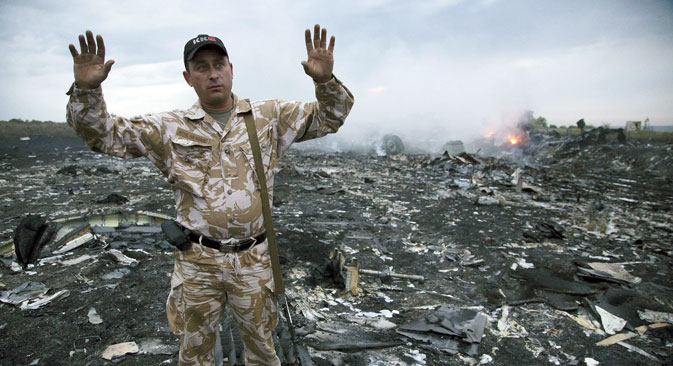
A plane en route from Amsterdam to Kuala Lumpur crashed in the Donetsk Region on July 17. Source: AP
The Kommersant newspaper writes that the leadership of the unrecognized People's Republic of Donetsk has announced that at the time of the Boeing's crash the militia shot down a Ukrainian AN-26. The Ukrainian side, on the other hand, states that it was the militias, who, having confused targets, attacked the civilian aircraft.
"It is important to note that both sides of the conflict are equipped with BUK anti-aircraft missiles, which are capable of hitting an aircraft at a significant altitude," the newspaper emphasizes. Kommersant informs its readers that the plane fell in the area controlled by the authorities of the unrecognized republic, which is why it is the militias that have organized the search for the dead bodies and the flight recorders.
Russia confirms operation of Ukrainian long-range defense systems on day of MH17 crash
181 bodies found at air crash site in Donetsk region
Four Ukrainian experts, 17 OSCE representatives travel to Boeing crash site
The Ukrainian side has announced that it intends to carry out its own investigation with the help of international specialists, including from the Boeing Company.
Ukrainian officials have said that the so-called People's Republic of Donetsk is armed with BUK anti-aircraft missiles, which were capable of shooting down the Boeing at an altitude of 33,000 feet. Ukrainian military expert Igor Levchenko told Kommersant that he thinks the government forces also have a few BUKs in the combat zone, however, "these missiles are used in antiterrorist operations and it is therefore unlikely that they would be used to shoot down a passenger airliner."
Kommersant also states that the Malaysian airliner crash in Ukraine almost immediately became a question of big politics: The government in Kiev said that it was the militias who shot down the plane, and President Petro Poroshenko even said it was a terrorist act. "In the West the reactions have been cautious," writes the newspaper.
Nezavisimaya Gazeta writes that "the White House, demanding an inquiry into the tragedy, is criticizing Moscow, which, in its view, has continuously aggravated the conflict in southeast Ukraine, supported the separatists, training and arming them."
According to the newspaper, the general opinion in the U.S. is that the missile was fired either by the militias or by Russian soldiers. The newspaper notes that America is not blaming Kiev, and that Ukraine has announced that in the entire conflict it has not fired any missiles capable of hitting a plane at a 33,000-foot altitude.
Gazeta.ru says that the most likely explanation for the airplane crash in eastern Ukraine was the BUK anti-aircraft missile, which is the most powerful means of anti-aircraft defense, one that Ukraine inherited from the USSR and that has recently come into the militia's possession. The newspaper analyzes the weapon's technical characteristics in depth: The BUK anti-aircraft missile is one of Russian arms exporter Rosoboronexport's most popular products.
Gazeta.ru says that the missiles are sold in all CIS countries that used them in Soviet times. Today the missiles are also used in countries such as Syria and Afghanistan. According to the publication, the missile system's technical specifics allow it to hit a target at an altitude of up to 82,000 feet. Moreover, the system is mobile: It can be packed up in five minutes. "Qualified specialists are required to take aim with this system. In their hands the BUK can hit a target even at a distance of 40 kilometers [130,000 feet]," says Gazeta.ru.
While the self-proclaimed People's Republic of Donetsk has been saying that it lacks the weapons needed to shoot down a plane at such a high altitude, officials from the neighboring “People's Republic” of Lugansk proposed another theory: the Malaysian Boeing 777 was shot down by the Ukrainian SU-25 jet, which was later shot down by the militias. However, the maximum altitude of the SU-25 is 16,500 feet, which makes this an unlikely version of events, says Gazeta.ru.
Vzglyad newspaper emphasizes that the "airplane fell precisely in the area of the most intense fighting between the Donetsk militias and the Ukrainian Army. The Ukrainian government blames the militias for the anti-aircraft tragedy. However, arguments blaming the Ukrainian soldiers are more convincing, says the publication.
Vzglyad notes that the Ukrainian press has already blamed the Donbass militias for the crash, saying that recently they have shot down two Ukrainian Air Force transportation planes. Moreover, the newspaper says that the BUK is a semiautomatic system, and human participation is minimal.
"Therefore the militias could have easily mastered the technology, since they have people who worked with this system while serving in the Soviet and then the Ukrainian army," Vzglyad suggests.
If it is so, then it is no longer the militias fighting the Ukrainian Air Force with anti-aircraft missiles that are the cause of the event, but rather "the western governments, who are encouraging Kiev to ‘establish order' in eastern Ukraine, the newspaper believes.
Military expert and editor-in-chief of National Defense magazine Igor Korotchenko suggests that "due to the personnel's low qualification and miscalculations, the operator either accidentally or unintentionally launched the missile that shot down the Boeing."
Furthermore, Vzglyad's expert says that earlier there was information of the militias having captured several BUK anti-aircraft missile launchers, yet officially the Ukrainian government announced that they were faulty and therefore had been intentionally removed from combat by the Ukrainian soldiers.
All rights reserved by Rossiyskaya Gazeta.
Subscribe
to our newsletter!
Get the week's best stories straight to your inbox